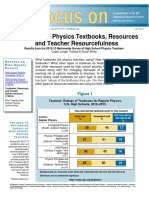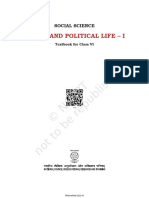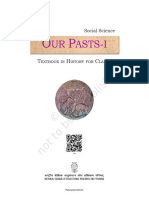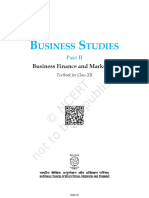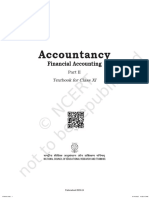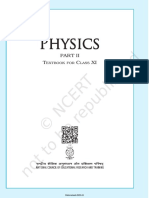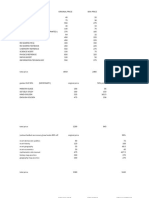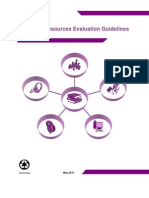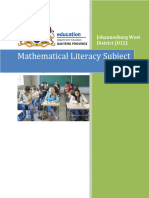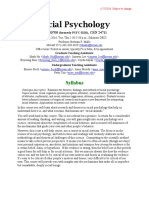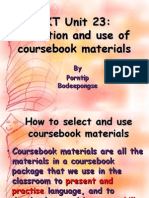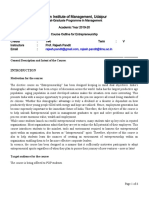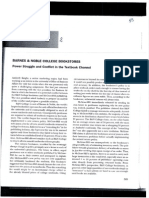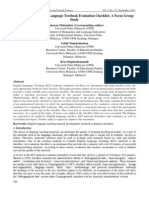Fess 3 Ps
Fess 3 Ps
Uploaded by
W1z ArdCopyright:
Available Formats
Fess 3 Ps
Fess 3 Ps
Uploaded by
W1z ArdOriginal Title
Copyright
Available Formats
Share this document
Did you find this document useful?
Is this content inappropriate?
Copyright:
Available Formats
Fess 3 Ps
Fess 3 Ps
Uploaded by
W1z ArdCopyright:
Available Formats
SOCIAL SCIENCE
SOCIAL AND POLITICAL LIFE – I
Textbook for Class VI
Rationalised 2023-24
Prelims.indd 1 18-11-2022 09:52:10 AM
0658 – Social and Political Life-I ISBN 81-7450-511-3
Textbook for Class VI
First Edition ALL RIGHTS RESERVED
February 2006 Phalguna 1927 No part of this publication may be reproduced, stored in a retrieval system
or transmitted, in any form or by any means, electronic, mechanical,
Reprinted photocopying, recording or otherwise without the prior permission of the
publisher.
December 2006, December 2007 This book is sold subject to the condition that it shall not, by way of trade, be lent,
December 2009, January 2011 re-sold, hired out or otherwise disposed of without the publisher’s consent, in
any form of binding or cover other than that in which it is published.
February 2012, November 2012 The correct price of this publication is the price printed on this page, Any
November 2013, January 2015 revised price indicated by a rubber stamp or by a sticker or by any other
means is incorrect and should be unacceptable.
January 2017, January 2018
February 2019, January 2020
March 2021, August 2021 OFFICES OF THE PUBLICATION
November 2021, and February 2022 DIVISION, NCERT
NCERT Campus
Sri Aurobindo Marg
Revised Edition New Delhi 110 016 Phone : 011-26562708
November 2022 Kartika 1944
108, 100 Feet Road
Hosdakere Halli Extension
PD 525T RSP Banashankari III Stage
Bengaluru 560 085 Phone : 080-26725740
© National Council of Educational
Navjivan Trust Building
Research and Training, 2006, 2022 P.O.Navjivan
Ahmedabad 380 014 Phone : 079-27541446
CWC Campus
Opp. Dhankal Bus Stop
Panihati
Kolkata 700 114 Phone : 033-25530454
CWC Complex
Maligaon
Guwahati 781 021 Phone : 0361-2674869
` 65.00
Publication Team
Head, Publication : Anup Kumar Rajput
Division
Chief Production : Arun Chitkara
Officer
Chief Business : Vipin Dewan
Manager
Chief Editor (In charge) : Bijnan Sutar
Printed on 80 GSM paper with NCERT Production Assistant : Om Prakash
watermark
Published at the Publication Division by the Cover and Illustrations
Secretary, National Council of Educational Vishakha Prakash
Research and Training, Sri Aurobindo Layout
Marg, New Delhi 110 016 and printed at Sohan Pal, Mrityunjay Chatterjee
Saraswati Offset Printers (P.) Ltd., A-5,
Naraina Industrial Area, Phase-II, Naraina,
New Delhi-110 028
Rationalised 2023-24
Prelims.indd 2 18-11-2022 09:52:10 AM
Foreword
The National Curriculum Framework (NCF), 2005, recommends that children’s
life at school must be linked to their life outside the school. This principle
marks a departure from the legacy of bookish learning which continues to
shape our system and causes a gap between the school, home and community.
The syllabi and textbooks developed on the basis of NCF signify an attempt
to implement this basic idea. They also attempt to discourage rote learning
and the maintenance of sharp boundaries between different subject areas.
We hope these measures will take us significantly further in the direction
of a child-centred system of education outlined in the National Policy on
Education (1986).
The success of this effort depends on the steps that school principals
and teachers will take to encourage children to reflect on their own learning
and to pursue imaginative activities and questions. We must recognise that
given space, time and freedom, children generate new knowledge by engaging
with the information passed on to them by adults. Treating the prescribed
textbook as the sole basis of examination is one of the key reasons why other
resources and sites of learning are ignored. Inculcating creativity and initiative
is possible if we perceive and treat children as participants in learning, not as
receivers of a fixed body of knowledge.
These aims imply considerable change in school routines and mode of
functioning. Flexibility in the daily time-table is as necessary as rigour in
implementing the annual calendar so that the required number of teaching
days is actually devoted to teaching. The methods used for teaching and
evaluation will also determine how effective this textbook proves for making
children’s life at school a happy experience, rather than a source of stress or
boredom. Syllabus designers have tried to address the problem of curricular
burden by restructuring and reorienting knowledge at different stages with
greater consideration for child psychology and the time available for teaching.
The textbook attempts to enhance this endeavour by giving higher priority
and space to opportunities for contemplation and wondering, discussion in
small groups, and activities requiring hands-on experience.
National Council of Educational Research and Training (NCERT) appreciates
the hard work done by the textbook development committee responsible for
this book. We wish to thank the Chairperson of the advisory committee for
Social Science textbooks at the Upper Primary Level, Professor Hari Vasudevan
and the Chief Advisor for this book, Sarada Balagopalan, for guiding the work
of this committee. Several teachers contributed to the development of this
textbook; we are grateful to their principals for making this possible. We are
Rationalised 2023-24
Prelims.indd 3 18-11-2022 09:52:10 AM
iv
indebted to the institutions and organisations which have generously permitted
us to draw upon their resources, material and personnel. We are especially
grateful to the members of the National Monitoring Committee, appointed
by the Department of Secondary and Higher Education, Ministry of Human
Resource Development under the Chairpersonship of Professor Mrinal Miri
and Professor G.P. Deshpande, for their valuable time and contribution. As an
organisation committed to the systemic reform and continuous improvement
in the quality of its products, NCERT welcomes comments and suggestions
which will enable us to undertake further revision and refinement.
Director
New Delhi National Council of Educational
20 December 2005 Research and Training
Rationalised 2023-24
Prelims.indd 4 18-11-2022 09:52:11 AM
Rationalisation of Content in the Textbooks
In view of the COVID-19 pandemic, it is imperative to reduce content
load on students. The National Education Policy 2020, also emphasises
reducing the content load and providing opportunities for experiential
learning with creative mindset. In this background, the NCERT has
undertaken the exercise to rationalise the textbooks across all classes.
Learning Outcomes already developed by the NCERT across classes have
been taken into consideration in this exercise.
Contents of the textbooks have been rationalised in view of the
following:
• Overlapping with similar content included in other subject areas in the
same class
• Similar content included in the lower or higher class in the same subject
• Difficulty level
• Content, which is easily accessible to students without much
interventions from teachers and can be learned by children through
self-learning or peer-learning
• Content, which is irrelevant in the present context
This present edition, is a reformatted version after carrying out the
changes given above.
Rationalised 2023-24
Prelims.indd 5 18-11-2022 09:52:11 AM
Rationalised 2023-24
Prelims.indd 6 18-11-2022 09:52:11 AM
Textbook Development Committee
Chairperson, Advisory Committee for Social Science Textbooks at the
Upper Primary Level
Hari Vasudevan, Professor, Department of History, University of Calcutta,
Kolkata
Chief Advisor
Sarada Balagopalan, Centre for the Study of Developing Societies (CSDS),
Rajpur Road, Delhi
Members
Anjali Noronha, Eklavya – Institute for Educational Research and Innovative
Action, Madhya Pradesh
Arvind Sardana, Eklavya – Institute for Educational Research and Innovative
Action, Madhya Pradesh
Dipta Bhog, Nirantar – Centre for Gender and Education, Sarvodaya
Enclave, New Delhi
Jaya Singh, Lecturer, DESSH, NCERT
Krishna Menon, Reader, Lady Shri Ram College, University of Delhi, Delhi.
Latika Gupta, Consultant, DEE, NCERT
Mohan Deshpande, Coordinator, Aabha (Arogya Bhan), Aundh, Pune
M.V. Srinivasan, Lecturer, DESSH, NCERT
Sanjay Dubey, Reader, DESSH, NCERT
Shobha Bajpai, Government Middle School, Uda, District Harda, Madhya
Pradesh
Swati Verma, Heritage School, Sector-23, Rohini, Delhi
Member-Coordinator
W. Themmichon Ramson, Lecturer, DESSH, NCERT
Rationalised 2023-24
Prelims.indd 7 18-11-2022 09:52:11 AM
Constitution of India
Part IV A (Article 51 A)
Fundamental Duties
It shall be the duty of every citizen of India —
(a) to abide by the Constitution and respect its ideals and institutions, the
National Flag and the National Anthem;
(b) to cherish and follow the noble ideals which inspired our national
struggle for freedom;
(c) to uphold and protect the sovereignty, unity and integrity of India;
(d) to defend the country and render national service when called upon to
do so;
(e) to promote harmony and the spirit of common brotherhood amongst
all the people of India transcending religious, linguistic and regional
or sectional diversities; to renounce practices derogatory to the dignity
of women;
(f) to value and preserve the rich heritage of our composite culture;
(g) to protect and improve the natural environment including forests, lakes,
rivers, wildlife and to have compassion for living creatures;
(h) to develop the scientific temper, humanism and the spirit of inquiry
and reform;
(i) to safeguard public property and to abjure violence;
(j) to strive towards excellence in all spheres of individual and collective
activity so that the nation constantly rises to higher levels of endeavour
and achievement;
* (k) who is a parent or guardian, to provide opportunities for education
to his child or, as the case may be, ward between the age of six and
fourteen years.
Note: The Article 51A containing Fundamental Duties was inserted by the Constitution (42nd
Amendment) Act, 1976 (with effect from 3 January 1977).
*(k) was inserted by the Constitution (86th Amendment) Act, 2002 (with effect from
1 April 2010).
Rationalised 2023-24
Prelims.indd 8 18-11-2022 09:52:11 AM
Acknowledgments
The collective effort that this textbook represents extends beyond the formal writing team.
Several friends and colleagues were involved with this book in many ways. As members
of our self-initiated internal review committee Mary John, S. Mohinder, Aditya Nigam and
C.N. Subramaniam provided us with detailed feedback and inputs.
In addition, Solly Benjamin, Rajeev Bhargav, Anu Gupta, Sarah Joseph, Prakash Kant,
Prabhu Mahapatra, Farah Naqvi, Awadhendra Sharan, Sujit Sinha, Bhupendra Yadav and
Yogendra Yadav read particular chapters and commented on them. Alex M. George played
multiple roles in terms of providing us with ideas, feedback and information. Keshab Das
helped us think through one of our chapters with his detailed draft. Sumangala Damodaran
provided us the wording of the IPTA song that we have used in the first chapter. Ben
eagerly worked at providing us with information on rice cultivation in Chizami, Nagaland.
We specially would like to thank Urvashi Butalia who generously agreed to edit the
book at short notice. Her detailed editing and comments greatly enriched the quality of
the book, its presentation of ideas and our writing style.
We would like to thank R.K. Laxman (The Times of India), Sheila Dhir, Poile
Sengupta and Anjali Monteiro for permitting us to use their work and writings. We duly
acknowledge, Penguin, Tulika and the Government of Maharastra for allowing us to use
their publications.
Some of the illustrations in this book have been done by children. The children of
Government Middle School, Uda, District Harda have drawn the pictures used in the
collage on rural livelihoods. Aditi, Aishwarya, Anisha, Bali, Meenakshi and Sahar also
provided us with their drawings. Saswati Chaudhury has painted two of the illustrations
that we have used in the first chapter.
The photographs were generously provided by Down to Earth, Hindustan Times and
Nehru Memorial Library. We specially thank Outlook for the help and understanding
extended to us and to Jan Breman and Parthiv Shah for their Photographs.
The Centre for the Study of Developing Societies (CSDS); Eklavya; Nirantar – Centre
for Gender and Education and Ankur Society for Alternatives in Education played an
important institutional role in the evolution of the book by being patient with our constant
absences, our excessive demands and lending their help in whichever way we required.
Mr. Adhikari, Vikas, Sachin and Ghanshyam at CSDS, Dinesh Patil at Eklavya and Shalini
Joshi, Purwa Bhardwaj, Malini Ghosh, Prasanna and Anil Hasda at Nirantar have helped
us a great deal.
All of the above individuals – as parents, teachers or students – have a knowledge of
textbooks and became involved in this process out of a commitment to bettering the ways
in which we introduce children to new ideas.
Special thanks are due to Savita Sinha, Professor and Head, DESSH, NCERT for her
support during the development of this book.
The Council also gratefully acknowledges the contributions of Arvind Sharma, DTP
Operator during the preparation of the book.
The efforts of the Publication Department, NCERT in bringing out this book are also
highly appreciated. This textbook is a reflection of all of our efforts. Suggestions and
critical feedback on this book are welcome.
The contribution of M.V.S.V. Prasad, Assistant Professor, Department of Curriculum
Studies, NCERT, in reviewing and updating the current edition is appreciated.
The Council acknowledges the valuable inputs for analysing syllabi, textbook and the
content proposed to be rationalised for this edition by Kavita Jain, PGT, Political Science,
Ashok Vihar; Maneesha Pandey, Professor, Department of Political Science, Hindu College,
University of Delhi; Shankaran Sharan, Associate Professor, DESS, NCERT; Vanthangpui
Khobung, Assistant Professor, RIE, Bhopal, NCERT; and Sunita Kathuria, PGT, Political
Science, MCL Saraswati Bal Mandir, Hari Nagar, New Delhi.
Rationalised 2023-24
Prelims.indd 9 18-11-2022 09:52:11 AM
ON USING THIS BOOK
Why ‘Social and Political Life’?
Members of the team that drew up the National Curriculum Framework 2005 were of the
opinion that the subject ‘Civics’ grew out of a certain colonial past and therefore required
to be changed. In addition, members of the curriculum committee felt that civics had
been focused only on describing government institutions and programmes and needed
to develop a critical outlook. “Social and Political Life” is the new subject that emerged
out of this exercise. This new subject has also simultaneously expanded its scope by
including within its purview topics that deal with various aspects of social, political and
economic life.
What is different about ‘Social and Political Life’?
A great deal of effort has gone into consciously devising a different approach while writing
this textbook. The textbook incorporates a mix of the following three elements:
1) Recognising that children learn best through concrete experiences. We have tried
to discuss institutions and processes through incorporating these either in the
form of fictional narratives, or case-studies or exercises that draws on the child’s
experiences.
2) Introducing concepts with a view to enabling comprehension rather than the
retention of facts. Some of the ways in which we have done this is through
minimising a listing of information, through asking questions that encourage the
child to think, and through avoiding definitions wherever possible.
3) Keeping in mind that the child is already deeply enmeshed within familial and
social networks, we have tried to balance the ideal with the real in our discussion
of topics.
Children bring in a lot of what happens in the outside world to the classroom. The
discussion of topics draws upon as well as interrogates these understandings. The reality
is portrayed along with an analysis of how we could move towards the ideal. This ideal
is emphasised through the values that are enshrined in the Constitution and through
people’s struggles to achieve these.
This book is divided into four sections that focus on different concepts i.e. diversity,
government, local government and administration and livelihoods. Each section contains
chapters that elaborate and expand on these concepts.
Rationalised 2023-24
Prelims.indd 10 18-11-2022 09:52:11 AM
xi
I. Beginning Each Chapter
Each Chapter begins with two In the previous chapter you
have discussed the meanings
elements that have been introduced to of diversity. Sometimes people
Chapter 2
create an interest in the child to find who are ‘different’ from others
are teased, laughed at or not
out what the Chapter is about. The first
of these is the Introductory Box that Diversity and included in a certain activity
or group. We feel hurt, angry,
Discrimination
helpless or sad when friends
provides a brief glimpse into the contents or others treat us in such ways.
Have you ever wondered why
of what that Chapter will deal with. At this happens?
times it has questions that are designed In this chapter we will try and
both to generate curiosity as well as explore how such experiences
are related to the society we
to elicit the child’s experiences on the live in. We will look at how
particular topic. We have also begun each they are connected to the
inequalities that exist around
Chapter with a large visual. The reason us.
behind this is once again to enable the
child to conjecture, with the help of the
picture provided, what the particular
Chapter seeks to get across. Teachers are
encouraged to come up with their own
questions and visuals in addition to using
those provided in this book.
II. In-text Questions and Exercises
You will notice that all of the Chapters include
What were Hector and his classmates protesting about?
List five ways in which the non-whites were
boxes that contain in-text questions, discussion
discriminated against: boxes or exercises. These serve several purposes.
1.
2. One is to help the teacher gauge the extent to
3. which the student has understood what has
been discussed earlier in the Chapter.
3. Talk to a vegetable vendor or hawker
and find out how do they organise their Second is to expand on the student’s understanding
work, their way of preparing, purchasing,
selling etc. of concepts by attempting to locate these within a
4. Bachchu Manjhi has to think twice
before taking a day off from work. Why?
child’s own experiences.
Exercise: Look at the statements in the column on the left. Can you
identify which level they belong to? Place tick marks allow the student
The third is to to recall and make connections with what has been taught earlier.
allow the student Local State Central
to recall and make The decision of the Indian government to maintain peaceful
relations with Russia
connections with
what has been The decision of the West Bengal Government on whether to have
Board exam in Class 8 for all government schools.
taught earlier. Introduction of two new train connections between Jammu and
Bhubaneswar.
Rationalised 2023-24
Prelims.indd 11 18-11-2022 09:52:12 AM
xii
The discussion boxes are meant for discussion
Discuss in small groups which then later gets shared
Why do you think Samir Do did not attend school? with the whole class. These discussion boxes are
Do you think it would have been easy for him to central to the student experientially expanding
attend school if he wanted to? In your opinion is
upon their understanding of particular concepts
it a fair situation that some children get to go to
school and others don’t? and should therefore in no way be ignored for the
sake of time constraints.
III. End-Text Questions
In drafting the end-text questions, care has been taken to encourage the student to
understand rather than to blindly memorise the contents of the book. Students should
be encouraged to write the answers in their own words. Various types of questions have
been used. A brief explanation of three different types of questions are provided:
QUESTIONS »» One type requires the child to specifically recall
1. What is the work of the police? some of the main ideas of the Chapter.
2. List two things that the work of a
Patwari includes. 5. Fill in the following table to show the
services provided by people in the
markets which you visit frequently.
Name of the Nature of the
shop or office service provided
»» Another type asks the student to answer based on
their own experiences.
6. Compare the situation of Sekar and Ramalingam by filling »» There are compare and contrast
out the following table:
questions that ask the student to think
SEKAR RAMALINGAM
through the information presented to
them
Land
cultivated
Labour
required
Selling of
harvest 6. Read the following news item.
...The incident came to light when some villagers brought a badly
injured Lad to hospital for treatment. In the FIR recorded by the police
Lad said that he was attacked when he insisted that the water in
the tanker must be emptied into the storage tanks constructed as
»» Questions also ask the part of the water supply scheme by Nimone Gram Panchayat so
student to imagine a that there would be equal distribution of water. However, he alleged
that the upper caste men were against this and told him that the
situation that they have tanker water was not meant for the lower castes.
Adapted from Indian Express, May 1, 2004
read about and react to a. Why was Bhagvan beaten?
the issues it throws up. b. Do you think that the above is a case of discrimination? Why?
Rationalised 2023-24
Prelims.indd 12 18-11-2022 09:52:12 AM
xiii
7. Discuss:
In the two photographs »» Another type has used
you see different ways of
collecting and disposing visuals/ photos to ask the
garbage. student to describe what they
i) Which way do you see and how it relates to what
think provides safety they have read in the Chapter.
to the person disposing
garbage?
These various types of questions will allow the teacher to evaluate whether the child has
not only understood a concept but that this learning includes an ability to relate to the
concept meaningfully. The teacher is encouraged to set questions of various types, like
the ones described above, when evaluating the student. It is important that we formulate
new questions, similar to the end-text questions. We must try to abandon the practice of
students ‘learning’ answers to a fixed set of questions. Expressing opinion, or debating
on certain issues is part of engaging with or learning a concept.
IV. Use of Narratives
I meant it as a joke. This book uses several narratives, both fiction and non- fiction,
A joke for the small
ragged boy who sold
to enable the child to understand ideas and institutions. These
newspapers at the narratives should be used to encourage introspection as well
traffic light at the busy
intersection. Every time as discussion, with the effort being to have the student identify
I cycled past he would as much as possible with the story. In some Chapters we
run after me, holding
out the English paper have asked students to write narratives of their own based on
their experiences of
and screaming out the evening’s
headlines in a mixture of Hindi and
similar situations.
English. This time, I stopped by the Bachchu Manjhi – A Cycle-Rickshaw Puller
pavement and asked for the Hindi
The student should
paper. His mouth fell open... I come from a village in Bihar where I worked as a mason.
be encouraged to My wife and three children live in the village. We don’t own
land. In the village I did not get masonry work regularly. The
be as creative as possible while writing and income that I earned was not sufficient for our family.
narrating these stories. The teacher is also After I reached this city, I bought an old cycle rickshaw and
paid for it in instalments. This was many years ago...
encouraged to look for linkages that can be
made with concepts that are being taught in
the other subjects.
Imagine that you are a writer or an artist who lives in the place
described above. Either write a story or draw a picture of your
life here.
Do you think you would enjoy living in a place like this? List five
different things that you would miss the most if you lived here.
Rationalised 2023-24
Prelims.indd 13 18-11-2022 09:52:13 AM
xiv
V. Use of Images
This book contains several illustrations and
photographs. These are as integral to the Chapter
as the narrative is and the teacher is encouraged to
use these in explaining the narrative contents of this
book. In addition pictures help the child visualise a
situation even if the child is not familiar with it. The
teacher is encouraged to use relevant visual material
in the classroom in addition to what is provided here.
The library, newspaper, magazines, the internet are
all a potential source of visuals and should be used
whenever possible.
VI. Use of other Sources
Letters to the editor
A textbook is important
but only one among many
sources that can be used
in a classroom. Students
should be encouraged to
read outside their textbooks.
One way would be to find
out answers to some of
the questions raised in the
class in other sources like
Not bad! One of the taps in the the newspaper, magazines,
nearby village must be getting books etc.
water!
Rationalised 2023-24
Prelims.indd 14 18-11-2022 09:52:14 AM
CONTENTS xv
Foreword iii
Rationalisation of Content in the Textbook v
On Using this Book vii
UNIT I DIVERSITY
Chapter 1 Understanding Diversity 3
Chapter 2 Diversity and Discrimination 13
UNIT II GOVERNMENT
Chapter 3 What is Government 26
UNIT III LOCAL GOVERNMENT AND
ADMINISTRATION
Chapter 4 Panchayati Raj 36
Chapter 5 Rural Administration 42
Chapter 6 Urban Administration 50
UNIT IV LIVELIHOODS
Chapter 7 Rural Livelihoods 60
Chapter 8 Urban Livelihoods 69
References 79
Rationalised 2023-24
Prelims.indd 15 18-11-2022 09:52:15 AM
Rationalised 2023-24
Prelims.indd 16 18-11-2022 09:52:16 AM
You might also like
- High School Physics TextbooksDocument16 pagesHigh School Physics TextbooksPreeti Ratnam100% (1)
- Financial Accounting SyllabusDocument6 pagesFinancial Accounting SyllabusIan Wang100% (1)
- BIOS 2050 SyllabusDocument8 pagesBIOS 2050 SyllabusAnonymous Iv5wiBmFKNo ratings yet
- Politics 6thDocument96 pagesPolitics 6thRadhika GoelNo ratings yet
- Polity 6thDocument96 pagesPolity 6thMandeep BeniwalNo ratings yet
- Class 7 - SociologyDocument126 pagesClass 7 - SociologyHarshit DayalNo ratings yet
- History 7 THDocument120 pagesHistory 7 THTushar KumarNo ratings yet
- History 6thDocument124 pagesHistory 6thRadhika GoelNo ratings yet
- Gehc 1 PsDocument12 pagesGehc 1 Pselysion.011No ratings yet
- Gess 3 PsDocument19 pagesGess 3 PsSrijan Prakash (Shankar)No ratings yet
- Hess2ps PDFDocument12 pagesHess2ps PDFAtharva ghogaleNo ratings yet
- Lesy 1 PsDocument14 pagesLesy 1 PsBrijnandan KumarNo ratings yet
- Civics 7Document115 pagesCivics 7Aryan Xworld007No ratings yet
- Gess 3 PsDocument18 pagesGess 3 Psharshahir4432No ratings yet
- English NcertDocument152 pagesEnglish NcertYasir SaeedNo ratings yet
- Gehc 1 PsDocument12 pagesGehc 1 PsRaghavendra Rao TholetiNo ratings yet
- Business Studies: Textbook For Class XIDocument10 pagesBusiness Studies: Textbook For Class XIMonu KumarNo ratings yet
- Keac 1 PsDocument12 pagesKeac 1 Psvishnujoshi4269No ratings yet
- NCERT-Accountancy Book 1Document288 pagesNCERT-Accountancy Book 1KalyanNo ratings yet
- Gess 1 PsDocument14 pagesGess 1 PsPrerna RajputNo ratings yet
- Jess 4 PsDocument14 pagesJess 4 PsopNo ratings yet
- Ps Prelims BookDocument12 pagesPs Prelims Bookdavelkiller69No ratings yet
- Usiness Tudies: Business Finance and MarketingDocument10 pagesUsiness Tudies: Business Finance and Marketingsumeetangural123No ratings yet
- NCERT Class 8 GeographyDocument64 pagesNCERT Class 8 GeographyvikbhartiNo ratings yet
- Lesy 2 PsDocument14 pagesLesy 2 PsLogic BaluNo ratings yet
- Keac 2 PsDocument12 pagesKeac 2 PsarunrajNo ratings yet
- Lesy 1 PsDocument14 pagesLesy 1 PsABHIMAT PANDEYNo ratings yet
- Sociology 12Document151 pagesSociology 12majhimoni.2020No ratings yet
- 10th Science TexbookDocument2 pages10th Science TexbookTotal GyanNo ratings yet
- Keph2ps Merged PDFDocument164 pagesKeph2ps Merged PDFNimal 007No ratings yet
- Jess 4 PsDocument14 pagesJess 4 PsYESHWANTH KANIKENo ratings yet
- Chemistry Part-2 (Class 11)Document108 pagesChemistry Part-2 (Class 11)Sriram PrustyNo ratings yet
- Chemistry: Textbook For Class XIDocument10 pagesChemistry: Textbook For Class XIPain MiseryNo ratings yet
- 2023-24 NCERT 10 SST (Pol Sci) Complete BookDocument88 pages2023-24 NCERT 10 SST (Pol Sci) Complete Bookamandeep63kaurNo ratings yet
- Lehe 1 PsDocument24 pagesLehe 1 PsAmit Prakash SahooNo ratings yet
- Fesc 1 PsDocument12 pagesFesc 1 Psvempati srilathaNo ratings yet
- Science (Class 6)Document136 pagesScience (Class 6)Sriram PrustyNo ratings yet
- Business Studies Part IIDocument104 pagesBusiness Studies Part IIHome Grown CreationNo ratings yet
- Lebo 1 PsDocument12 pagesLebo 1 Pstanays.rprNo ratings yet
- Usiness Tudies: Business Finance and MarketingDocument10 pagesUsiness Tudies: Business Finance and MarketingAyushNo ratings yet
- 11th Chemistry Part-IIDocument108 pages11th Chemistry Part-IIsirivanth17No ratings yet
- Kech 2 PsDocument10 pagesKech 2 Psankitpp9899No ratings yet
- Keac 1 PsDocument12 pagesKeac 1 PsS'il Vous PlaîtNo ratings yet
- PisoDocument1 pagePisosaurabh joshiNo ratings yet
- Kebs 1 PSGVDocument10 pagesKebs 1 PSGVbirovishalNo ratings yet
- Lehe1ps (1) MergedDocument231 pagesLehe1ps (1) MergedJeevansh WadhwaNo ratings yet
- Lehe 1 PsDocument24 pagesLehe 1 Pspspasp213No ratings yet
- Legy 2 PsDocument10 pagesLegy 2 Psshrutisinha5439No ratings yet
- Leps 2 PsDocument13 pagesLeps 2 Psmpshekhawat451No ratings yet
- Geography 9Document68 pagesGeography 9akarshakarsh915No ratings yet
- Iess 1 PsDocument10 pagesIess 1 PsEkta YadavNo ratings yet
- SCIENCE NCERT (Dragged)Document1 pageSCIENCE NCERT (Dragged)rydywyhsmdNo ratings yet
- Kehe 2 PsDocument14 pagesKehe 2 Pstimeecoffee46No ratings yet
- Keph 2 PsDocument16 pagesKeph 2 PsVAMSI KRISHNANo ratings yet
- Olitics in Ndia Since Ndependence: T P S C XiiDocument13 pagesOlitics in Ndia Since Ndependence: T P S C XiiKeshav AgarwalNo ratings yet
- Quick BallDocument1 pageQuick BallW1z ArdNo ratings yet
- Drow Rogue 1Document1 pageDrow Rogue 1W1z ArdNo ratings yet
- Invention of ComputersDocument1 pageInvention of ComputersW1z ArdNo ratings yet
- Travel (Poem - Grade 6)Document3 pagesTravel (Poem - Grade 6)W1z Ard100% (2)
- THE BANYAN TREE by Rabindranath TagoreDocument7 pagesTHE BANYAN TREE by Rabindranath TagoreW1z Ard67% (3)
- Fess 302Document11 pagesFess 302W1z ArdNo ratings yet
- Matilda Can Do MagicDocument2 pagesMatilda Can Do MagicW1z Ard100% (3)
- 25 Strongest Devil Fruits in One PieceDocument28 pages25 Strongest Devil Fruits in One PieceW1z ArdNo ratings yet
- Probable Verses - LK 10,11,12Document2 pagesProbable Verses - LK 10,11,12W1z ArdNo ratings yet
- HY - ANSWER KEY - GRAM&COMPREHENSION Answer KeyDocument3 pagesHY - ANSWER KEY - GRAM&COMPREHENSION Answer KeyW1z ArdNo ratings yet
- Hy Revision Grammar&comprehensionDocument5 pagesHy Revision Grammar&comprehensionW1z ArdNo ratings yet
- Accounting Information Systems Basic Concepts and Current Issues 4th Edition Hurt Solutions Manual Full Chapter PDFDocument36 pagesAccounting Information Systems Basic Concepts and Current Issues 4th Edition Hurt Solutions Manual Full Chapter PDFLaurenColeqdrp100% (23)
- Feature and Article WritingDocument145 pagesFeature and Article WritingOzurumba ugochukwuNo ratings yet
- Bio1A03 F2021 Course OutlineDocument20 pagesBio1A03 F2021 Course OutlineManya MNo ratings yet
- Creativity SyllabusDocument6 pagesCreativity SyllabusAijazuddinNo ratings yet
- Second Hand Books ListDocument2 pagesSecond Hand Books Listgamingaarush4No ratings yet
- Introducing Critical Thinking As A New Subject To Higher Education in UzbekistanDocument2 pagesIntroducing Critical Thinking As A New Subject To Higher Education in UzbekistanFotima AbdikarimovaNo ratings yet
- Universities Serbia EBA Letters PDFDocument167 pagesUniversities Serbia EBA Letters PDFArun BavaNo ratings yet
- Term 1 - Commerce F4 SOW 2021-2022Document6 pagesTerm 1 - Commerce F4 SOW 2021-2022Aejaz MohamedNo ratings yet
- Learning Resource Evaluation GuidelinesDocument27 pagesLearning Resource Evaluation GuidelinesArgel Jermen A. JuanNo ratings yet
- High Level EJU Preparation Textbook - A Comprehensive Course On Japan and The World - Nipponrama StoreDocument4 pagesHigh Level EJU Preparation Textbook - A Comprehensive Course On Japan and The World - Nipponrama StoreAdarsh KolavennuNo ratings yet
- Subject Policy Maths LiteracyDocument14 pagesSubject Policy Maths LiteracyTererai Lalelani Masikati HoveNo ratings yet
- Clps 700 Socpsy SyllabusDocument8 pagesClps 700 Socpsy SyllabuslucyhywNo ratings yet
- TKT Unit 23Document19 pagesTKT Unit 23Porntip Bodeepongse รักในหลวง100% (1)
- AE PGP ENT Course - IIMU 2019.06.22 - Subject To RevisionDocument6 pagesAE PGP ENT Course - IIMU 2019.06.22 - Subject To RevisionVinay KumarNo ratings yet
- Makalah Literature (Selecting Text)Document14 pagesMakalah Literature (Selecting Text)Lita Trii LestariNo ratings yet
- Senior 1 Book List 2022 - 2023Document1 pageSenior 1 Book List 2022 - 2023Jose Anto BrilstonNo ratings yet
- Supplementary Reader in English For Class XII (Core Course)Document10 pagesSupplementary Reader in English For Class XII (Core Course)KNOWLEDGE REQUIREDNo ratings yet
- Grade 2 Math Weekly AgendaDocument5 pagesGrade 2 Math Weekly AgendaWaqas AhmedNo ratings yet
- DTU Student HandbookDocument29 pagesDTU Student HandbookSidharth AryaNo ratings yet
- Power Systems Guides Book by CL Wadhwa PDFDocument3 pagesPower Systems Guides Book by CL Wadhwa PDFAnkit Kumar0% (4)
- Argumentative EssysDocument10 pagesArgumentative EssysAlli AzeezNo ratings yet
- Caz 2 Barnes & Noble College Bookstores PDFDocument3 pagesCaz 2 Barnes & Noble College Bookstores PDFPartas LaurentiuNo ratings yet
- Nur1006 PreworkDocument2 pagesNur1006 PreworkJenniferNo ratings yet
- English For Ethiopia: Grade 6Document3 pagesEnglish For Ethiopia: Grade 6Esrom Abebe100% (2)
- Zewdu NigussieDocument130 pagesZewdu Nigussieምንሼ ነው ዘመኑ100% (2)
- Semi-Detailed LP in MathematicsDocument4 pagesSemi-Detailed LP in MathematicsMaebelle AbalosNo ratings yet
- Developing An English Language Textbook Evaluation Checklist: A Focus Group StudyDocument7 pagesDeveloping An English Language Textbook Evaluation Checklist: A Focus Group StudycdjrhsNo ratings yet
